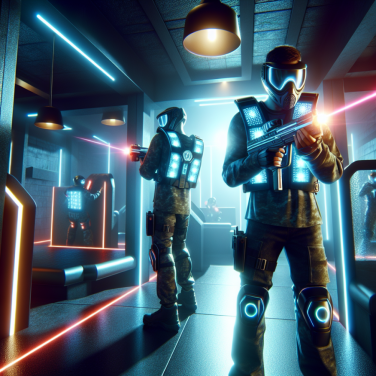Unveiling the Dynamics of Laser Tag: A Futuristic Battle Arena Experience
Unveiling the Dynamics of Laser Tag: A Futuristic Battle Arena Experience takes us into the enthralling world of laser tag, an interactive game where players engage in mock combat using infrared-emitting light guns. This high-energy activity transcends traditional boundaries of age and skill, welcoming participants into a realm where strategy, agility, and teamwork merge to create an unforgettable adrenaline rush.
At the core of laser tag is the technology that runs it – the laser tag equipment. The term 'laser' might be slightly misleading as the equipment uses safe, invisible infrared technology, similar to what you find in your television remote control. Participants wear vests equipped with sensors and wield hand-held 'phasers' that emit infrared beams. When these beams hit the sensors on an opponent's vest, the shooter's score is increased. This high-tech gear is what brings the video game experience to life in a physical, interactive setting.
The battle arena is a critical component of the laser tag experience. It is designed to immerse players into a different world, often themed as sci-fi landscapes, post-apocalyptic zones, or intergalactic platforms. This setting is enriched with obstacles, hideouts, and interactive elements that make strategic thinking and movement essential for success. Dim lighting and haze effects are employed to give the laser beams visibility, heightening the visual thrill of the game.
Modern laser tag arenas have evolved to include various game formats. The classic team-based match remains a staple, where coordination and group tactics can pave the way to victory. Solo matches, where it's every player for themselves, test individual skills and agility. Advanced systems offer specialized game modes such as Capture the Flag, Protect the VIP, and Zombie Infection, where the gameplay dynamics change, bringing in new challenges and strategies.
Another aspect of laser tag that adds depth to the experience is the scoring system and player statistics. Real-time scoring provides instant feedback on your performance and the status of the game. Some laser tag centers have adopted sophisticated software that tracks accuracy, hit-to-shot ratio, and even provides individual players with career stats across multiple visits, encouraging a continuous improvement and competitive spirit among participants.
Special equipment such as power-ups, base stations, and interactive props add layers of complexity to the game. Power-ups can grant temporary abilities such as rapid-fire, invisibility, or shield, while targeting base stations can involve more strategic objectives that can turn the tide of the game.
Read also:
Clash of Titans: The Ultimate Wheelstand Showdown
Harnessing Light for Combat: Strategies and Equipment in Laser Tag Warfare
When it comes to laser tag, the game goes beyond mere child's play—it's an intricate battle of strategy, precision, and technological prowess. To truly excel in this modern arena, one must understand the critical role light plays and how to manipulate it to their advantage. Mastery over the equipment and an understanding of the strategies involved can transform players from novices into feared combatants in the laser tag battlefield.
One of the primary considerations for any laser tag warrior is understanding the equipment at hand. The laser tag gun, or "phaser," is the primary tool of engagement, using infrared light to 'tag' opponents from a distance. These phasers are typically equipped with various settings allowing for different ranges, firing rates, and power levels, all of which can be tailored to the context of battle and the role of the player within a team.
The vest, usually woven with sensors that register hits from an opponent’s phaser, is the other vital piece of gear. Knowing the sensor layout is crucial; becoming adept at presenting the smallest possible target—a technique often referred to as 'sensor-shielding'—can drastically reduce the likelihood of being tagged.
Players well-versed in the art of laser tag also recognize the importance of stealth and camouflage. Dimly lit arenas can be rife with hiding spots or shadowy corners where light from the phaser would be less noticeable, giving players the element of surprise. Strobe lights, fog machines, and reflective surfaces can also be utilized to create confusion and disorient opponents, adding another layer of complexity to the game.
Advanced players often employ tactics similar to those used in military engagements. Teams develop formations such as the wedge or diamond to maximize their offensive capabilities while minimizing exposure. They use suppression fire to pin down opponents while teammates maneuver into more advantageous positions.
Communication is another essential factor—both verbal and non-verbal cues can coordinate team movements and signal impending threats. Seasoned teams often establish code words or hand signals to streamline their operations, ensuring that their plans are executed with precision and stealth.
Finally, strategic use of the geography of the laser tag arena can turn the tide of battle. Knowledge of choke points, high ground advantages, and natural lines of sight can allow teams to funnel opponents into traps or ambushes. Dominating key areas of the map can prevent opponents from moving freely and coordinating effectively.




